Channel Islands


| Island | Location | Notes |
|---|---|---|
| Jersey | The Elms | A horse-drawn apple crusher. |
| Guernsey | A horse-powered cider mill is preserved at the Folk museum. |
This is a list of horse mills that exist or are known to have existed.
| Province | Location | Notes |
|---|---|---|
| Antwerp | Antwerp | Brouwers Huis Museum |
| Antwerp | Ghent | Bas relief of a mediaeval horse mill on front of mill. |


| Island | Location | Notes |
|---|---|---|
| Jersey | The Elms | A horse-drawn apple crusher. |
| Guernsey | A horse-powered cider mill is preserved at the Folk museum. |
| County | Location | Notes |
|---|---|---|
| Vukovar-Srijem County | Otok | The local horse-powered "dry" mill (Croatian : Otočka suvara) is the symbol of- and is found in the coat of arms of the city. It is the last remaining mill of this type in Croatia. [1] |
| County | Location | Notes |
|---|---|---|
| Bedfordshire | Eversholt | A horse engine, now preserved at Billing Mill, Northamptonshire. |
| Kensworth | A donkey wheel from Nash Farm is preserved in Luton Museum and Art Gallery. | |
| Kensworth | There was a donkey wheel at Church End Farm. | |
| Sandy Heath | A horse powered wash mill was in use at the coprolite mine in the 1870s. | |
| Woburn | A horse-driven corn mill. | |
| Berkshire | Woolley Park | A horse-driven corn mill. |
| Buckinghamshire | Aylesbury | A horse wheel and churn are now preserved in the Science Museum (London). |
| Hawridge | A horse mill photographed in 1938 by Stanley Freese. | |
| Cambridgeshire | Fen Ditton | in 1251 the customary tenants of the bishop of Ely were required to use the horse mill even though other mills were available. |
| Horningsea | A horse-powered mill in 1251. | |
| Little Eversden | A horse mill £50 (on the coprolite workings).1871. | |
| Meldreth | A horse-powered mill was used to process material from coprolite mine between 1860 and 1890. | |
| Newton-in-the-Isle | A horse powered temporary woad mill that was subsequently moved to Parson Drove. | |
| Parson Drove | A horse driven temporary woad mill operated in Parson Drove, near Wisbech until the early 20th century. Previously used in Newton-in-the-Isle. Taken down in 1914. [2] model is on exhibition in Wisbech & Fenland museum. [3] | |
| Stretham | A horse powered washing mill for the coprolite mine c1870. | |
| Tydd St.Giles | A former location of the horse operated temporary woad mill that ended its days at Parson Drove. | |
| Wisbech | In 1251 a water mill, a horse mill, at which customary tenants were obliged to grind their corn, and a newly constructed wind mill. [4] | |
| Wisbech | In 1813 an excellent second-hand Horse Mill was for sale. Described as consisting of one horse wheel, 18 feet diameter : 2 sour ditto with upright shaft and iron work complete : one pair of stones, 4 feet diameter, and irons complete; stone bed frame, brig tree, stone cases, with hopper, screen, & c. Pump gears, shaft, cranks, and iron work to the same, all in excellent condition. Enquire of Mr. geo. Snarey, millwright, Wisbech. [5] | |
| Cheshire | Widnes | A horse-powered mill in Widnes in the 13th century. |
| Cornwall | Gwennap | A horse whim for raising ore. |
| Newquay | A horse gear for driving a threshing machine is preserved at the Dairyland museum. | |
| Cumberland | Cartmel | A horse gear is preserved at the Museum of Lakeland Life, Kendal. |
| Derbyshire | Castleton | A horse-powered ore crusher stood at SK135835 . |
| Devonshire | Bovey Tracey | A photo of the horse cider Press in Bovey Tracey. C1940. E.M.Gardiner. |
| Dunsford | Remains of a horse powered cider Press. Lowley Farm. | |
| Harberton | A photo of the cider Press in Harberton. c1940.Mills archive. | |
| Scorlinch, Clyst St. Lawrence | A horse engine. | |
| Weyland, Tedburn St. Mary | A horse-powered mill, extant in the 1920s. | |
| Durham | East Herrington | A horse-powered mine gin. |
| Beamish Museum | Oak and iron horse mill for threshing in situ in gin gang at Home Farm; unused since ca.1830. | |
| Hampshire | Southampton | A horse-powered pumping engine in the Weevil Brewery. Built by John Smeaton in 1780. |
| Herefordshire | Bacton | A contemporary horse powered cider Press at Fair Oak. [6] |
| Little Cowarne | A horse-powered cider mill located in the oast at Little Cowarne Court. | |
| Hertfordshire | Ashridge | A donkey wheel. |
| Isle of Wight | Carisbrooke | Carisbrooke Castle: a donkey wheel, extant. |
| Kent | Chilham | Chilham Castle: a horse wheel driving pumps. |
| Burham | Great Kewlands, a dog wheel for raising water. [7] | |
| West Kingsdown | A horse whim, now preserved at the Weald and Downland Open Air Museum, Singleton, Sussex. | |
| Lancashire | Preston | A horse powered spinning mill. [8] |
| Lincolnshire | Brothertoft | A horse powered permanent woad mill. In operation until the early 20th century. |
| Grimsby | A horse operated machine for grinding Malt was offered for sale by Messrs. Simpson & Reavis in 1809. [9] | |
| Spalding | A horse powered temporary woad mill. Later relocated and finally taken down at Parson Drove,Cambridgeshire. | |
| Sutterton | A horse powered Woad mill. [10] | |
| Whaplode Marsh | A horse powered temporary woad mill. Later relocated and finally taken down at Parson Drove, Cambridgeshire. | |
| London | A horse-powered pumping engine in the Chiswell Street brewery. | |
| Norfolk | Norwich | Catton mill: a horse and wind mill. |
| Earlham Hall: a horse mill. | ||
| Heigham: in a tannery | ||
| Mill Hill, Heigham: a horse and wind mill. | ||
| Pockthorpe mill: a horse and wind mill. | ||
| Attleborough | Great mill: a horse and wind mill. | |
| King's Lynn | Kettle mills: a horse-, wind- and water-mill. [11] | |
| Oulton | A horse and wind mill. | |
| Wymondham | A horse-powered mill. [12] | |
| Northumberland | Berwick Hill | A horse gin built in 1814. Now preserved at Beamish Museum. Cragend Farm Rothbury 1864 OS map A horse gin built earlier shown on OS map in 1864 latterly reconstructed by Loord Armstong of Cragside into a hydraulic machine room using water power. |
| Nottinghamshire | Nottingham | A horse powered cotton mill. [13] |
| Wollaton Park | A horse gin built at Langton Colliery in 1844 and later used at Pinxton Colliery. | |
| Oxfordshire | Rotherfield Greys. | Greys Court: a National Trust property, with a donkey wheel. |
| Great Tew | A horse-powered corn mill. | |
| Suffolk | Blythburgh | There was a horse wheel at Henham Hall now preserved at the Museum of East Anglian Life in Stowmarket. |
| Drinkstone. | The smock mill formerly had a horse mill in the base. | |
| Surrey | Cobham | A contemporary horse powered cider mill 'Horse Kick Cider Ltd' since 2016 |
| Painshill | A horse wheel used for raising water. In use from 1770 to the 1830s. | |
| Sussex | Patching | A pug mill, now preserved at the Weald and Downland Open Air Museum, Singleton |
| Mark Cross | a pug mill in a brickyard. | |
| Stanmer | A donkey wheel, in the churchyard of Stanmer Church. | |
| Saddlescombe | A donkey wheel at the farm, owned by the National Trust. [14] | |
| Wiltshire | Broad Hinton | A donkey wheel, demolished in 1908. |
| Tidworth | A horse-driven pump, working in the 1930s. | |
| Worcestershire | Burlingham | A horse-powered cider mill is preserved at Hartlebury Castle. |
| Yorkshire | Hutton-le-Hole | A horse mill is preserved at the Ryedale Folk Museum. |
| Stillington | A horse wheel now preserved at Shibden Hall. | |
| Sutton | A gorse crushing mill is preserved on the village green. |

| Département | Location | Notes |
|---|---|---|
| Drôme | Nyons | Les Vieux Moulins à huile, a watermill and also animal-powered mill. [15] |
| Lot | Varaire | Moulin à huile, an animal-powered oil mill. [15] |
| Tarn | Magrin | Musée du Pastel [15] |
| Var | Pontevès | Moulin de Pontevès, produced olive oil. [15] |
| Vaucluse | Gordes | Moulin des Bouillons, produced olive oil. [15] |
| Vaucluse | Joucas | Le Moulin à huile, produced olive oil. [15] |

| County | Location | Notes |
|---|---|---|
| Békés | Szarvas | A mill built in 1836. (Hungarian : szarvasi szárazmalom) is the last remaining horse-powered mill in its condition. [16] |
| Szabolcs-Szatmár-Bereg | Vámosoroszi | A reconstructed horse-powered mill built before 1840. is moved to the Hungarian Open Air Museum in Szentendre. [17] |
| Szabolcs-Szatmár-Bereg | Tarpa | An animal-powered mill reconstructed in 1980s is declared industrial-history landmark [18] and functions as an open-air cultural heritage museum. [19] |
| Voivodeship | Location | Notes |
|---|---|---|
| Lesser Poland | Wieliczka Salt Mine [20] | Three horse mills: Hungarian- and Saxon-types with vertical rope drums and Polish-type with a horizontal windlass |
| County | Location | Notes | |
|---|---|---|---|
| Aberdeenshire | Gartly | A horse mill for crushing gorse for fodder | |
| Ayrshire | Titwood Farm, Kilmaurs | ||
| Fife | Culross | Horse-gin built by Sir George Bruce c1590 to raise mine water from his Moat Pit, powered by 3 horses and using 36 buckets on a chain, working to a depth of 40 fathoms, known as the 'Egyptian Wheel'. At least 3 other horse-gins were in use at Culross Colliery between 1590 and 1676. | |
| Lanarkshire | Wester Kittochside, East Kilbride. | This example is at the Museum of Scottish Country Life and was recently dug out (2005) and partially restored to working condition. | |
| Orkney | Garson Farm, Stromness | ||
| Selkirkshire | Broomhill House, [21] Selkirk | Recently restored horse mill | |
| Shetland | Lund Farm, Unst | A horse gin, probably for powering a thresher in the barn. |

| District | Location | Notes |
|---|---|---|
| North Banat District | Suvača, Kikinda | Suvača is in 1990 proclaimed as a Monument of Culture of Exceptional Importance. |

| Province | Location | Notes |
|---|---|---|
| Canary Islands | Tefia, Puerto del Rosario | A donkey-powered mill preserved at La Alcogida Ecomuseum |
| County | Location | Notes |
|---|---|---|
| Caernarvonshire | Dullog, Rhostryfan, Caernarfon | An oblique dog-wheel. Now preserved at the Welsh Folk Museum, St. Fagans, Cardiff |
| Denbighshire | Wrexham | Bersham Colliery, a reconstruction of a horse gin. |
| Monmouthshire | Abergavenny | A dog-driven spit is preserved in the museum. |
| Pembrokeshire | Penysgwarne Farm, Tremarchog |
| State | Location | Notes |
|---|---|---|
| Indiana | Bottorff-McCulloch Farm |

Wisbech is a market town, inland port and civil parish in the Fenland district in Cambridgeshire, England. In 2011 it had a population of 31,573. The town lies in the far north-east of Cambridgeshire, bordering Norfolk and only 5 miles (8 km) south of Lincolnshire. The tidal River Nene running through the town is spanned by two road bridges. Wisbech is in the Isle of Ely and has been described as "the Capital of The Fens".
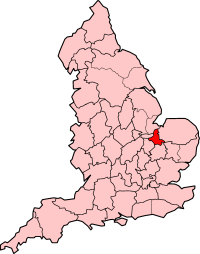
The Isle of Ely is a historic region around the city of Ely in Cambridgeshire, England. Between 1889 and 1965, it formed an administrative county.

Isatis tinctoria, also called woad, dyer's woad, dyer's-weed, or glastum, is a flowering plant in the family Brassicaceae with a documented history of use as a blue dye and medicinal plant. Its genus name, Isatis, derives from the ancient Greek word for the plant, ἰσάτις. It is occasionally known as Asp of Jerusalem. Woad is also the name of a blue dye produced from the leaves of the plant. Woad is native to the steppe and desert zones of the Caucasus, Central Asia to Eastern Siberia and Western Asia but is now also found in South-Eastern and Central Europe and western North America.

Whittlesey is a market town and civil parish in the Fenland district of Cambridgeshire, England. Whittlesey is 6 miles (10 km) east of Peterborough. The population of the parish was 17,667 at the 2021 Census.

March is a Fenland market town and civil parish in the Isle of Ely area of Cambridgeshire, England. It was the county town of the Isle of Ely which was a separate administrative county from 1889 to 1965. The administrative centre of Fenland District Council is located in the town.
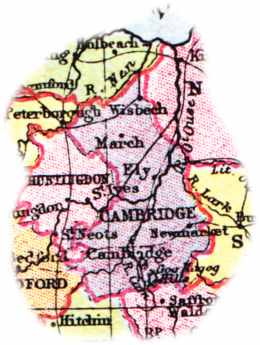
The English county of Cambridgeshire has a long history.

Pub names are used to identify and differentiate traditional drinking establishments. Many pubs are centuries old, and were named at a time when most of their customers were illiterate, but could recognise pub signs. The use of signage was not confined to drinking establishments. British pubs may be named after and depict anything from everyday objects, to sovereigns, aristocrats and landowners. Other names come from historic events, livery companies, occupations, sports, and craftsmen's guilds. One of the most common pub names is the Red Lion. This list contains both modern and historical examples.
Benwick is a village and civil parish in the Fenland district of Cambridgeshire, England. It is approximately 15 miles (24 km) from Peterborough and 30 miles (48 km) from Cambridge. The population of Benwick was recorded as 1137 in the United Kingdom Census 2011 with 452 households. The River Nene passes through the village, which is thus accessible by boat from the inland waterways network in England.
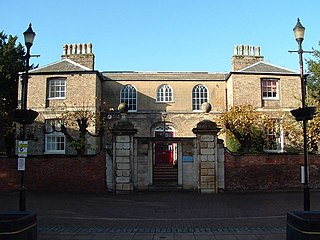
Wisbech Castle was a stone to motte-and-bailey castle built to fortify Wisbech on the orders of William I in 1072, it probably replaced an earlier timber and turf complex. The layout was probably oval in shape and size, on the line still marked by the Circus. The original design and layout is unknown. It was rebuilt in stone in 1087. The castle was reputedly destroyed in a flood in 1236. In the 15th century, repairs were becoming too much for the ageing structure, and a new building was started in 1478 under John Morton, Bishop of Ely. His successor, John Alcock, extended and completed the re-building and died in the Castle in 1500. Subsequent bishops also spent considerable sums on this new palace. The Bishop's Palace was built of brick with dressings of Ketton Stone, but its exact location is unknown.

Parson Drove is a fen village and civil parish in the Isle of Ely, Cambridgeshire, England. A linear settlement, it is 6 miles (10 km) west of Wisbech, the nearest town. The village is named after the central thoroughfare along which the village developed, a green drove, much wider than the current metalled road (B1166). The population at the 2001 Census was 1,030. The city of Peterborough is 19 miles (31 km) to the west, and the town of King's Lynn is 21 miles (34 km) to the east.
Wisbech is a former United Kingdom Parliamentary constituency. It was created upon the abolition of an undivided Cambridgeshire county constituency in 1885 and was itself abolished in 1918.
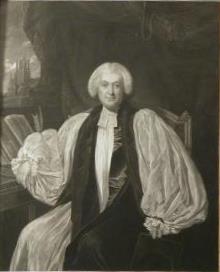
James Yorke was a British clergyman.

Walsoken is a settlement and civil parish in Norfolk, England, which is conjoined as a suburb at the northeast of the town of Wisbech, Isle of Ely, Cambridgeshire.
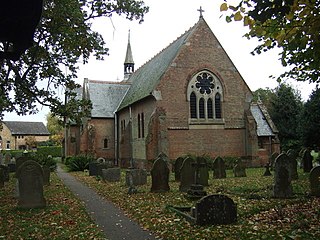
Christchurch is a village in the Fenland district of Cambridgeshire, England. The population of the civil parish at the 2011 Census was 833. The village is sited close to the Cambridgeshire/Norfolk border.
Tholomas Drove is a hamlet in Wisbech St Mary civil parish, part of the Fenland district in the Isle of Ely, Cambridgeshire, England. The population is included in the civil parish of Parson Drove. In 1989, there were 120 residents. The origins of the name are unclear but it has also been written as Tholomer's Drove and Tallamass Drove.
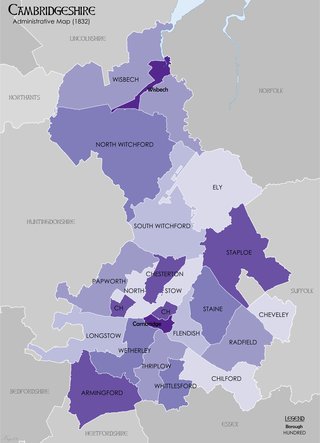
Between Anglo-Saxon times and the 19th century Cambridgeshire was divided for administrative purposes into 17 hundreds, plus the borough of Cambridge. Each hundred had a separate council that met each month to rule on local judicial and taxation matters.

Newton-in-the-Isle is a village and civil parish in the Fenland District of the Isle of Ely, Cambridgeshire, England, The village is 4 miles (6 km) to the north of Wisbech.
The Wisbech Stirs was a divisive quarrel between English Roman Catholic clergy held prisoner in Wisbech Castle in the Isle of Ely, Cambridgeshire, towards the end of the reign of Elizabeth I of England. It set some of the secular clergy against the regular clergy represented by the Society of Jesus, the religious institute that was emerging as clerical leaders, and who wished for a more ordered communal life in the prison.

Port of Wisbech is an inland port on the River Nene in Wisbech, Isle of Ely, Cambridgeshire, United Kingdom. It is mainly used for cargo and industrial purposes, with the southern part of the port housing a number of berths for yachts. Fenland District Council is the harbour authority for most of the River Nene; as well as operating the port and harbour, it provides a Port Health service to commercial ships, leisure craft and fishing vessels. The port runs a fortnightly service from Riga, Latvia importing from the Baltic.

North Cambridgeshire Hospital is a healthcare facility in The Park, Wisbech, Cambridgeshire, England. It is managed by the Cambridgeshire and Peterborough NHS Foundation Trust.
{{cite book}}: |website= ignored (help)